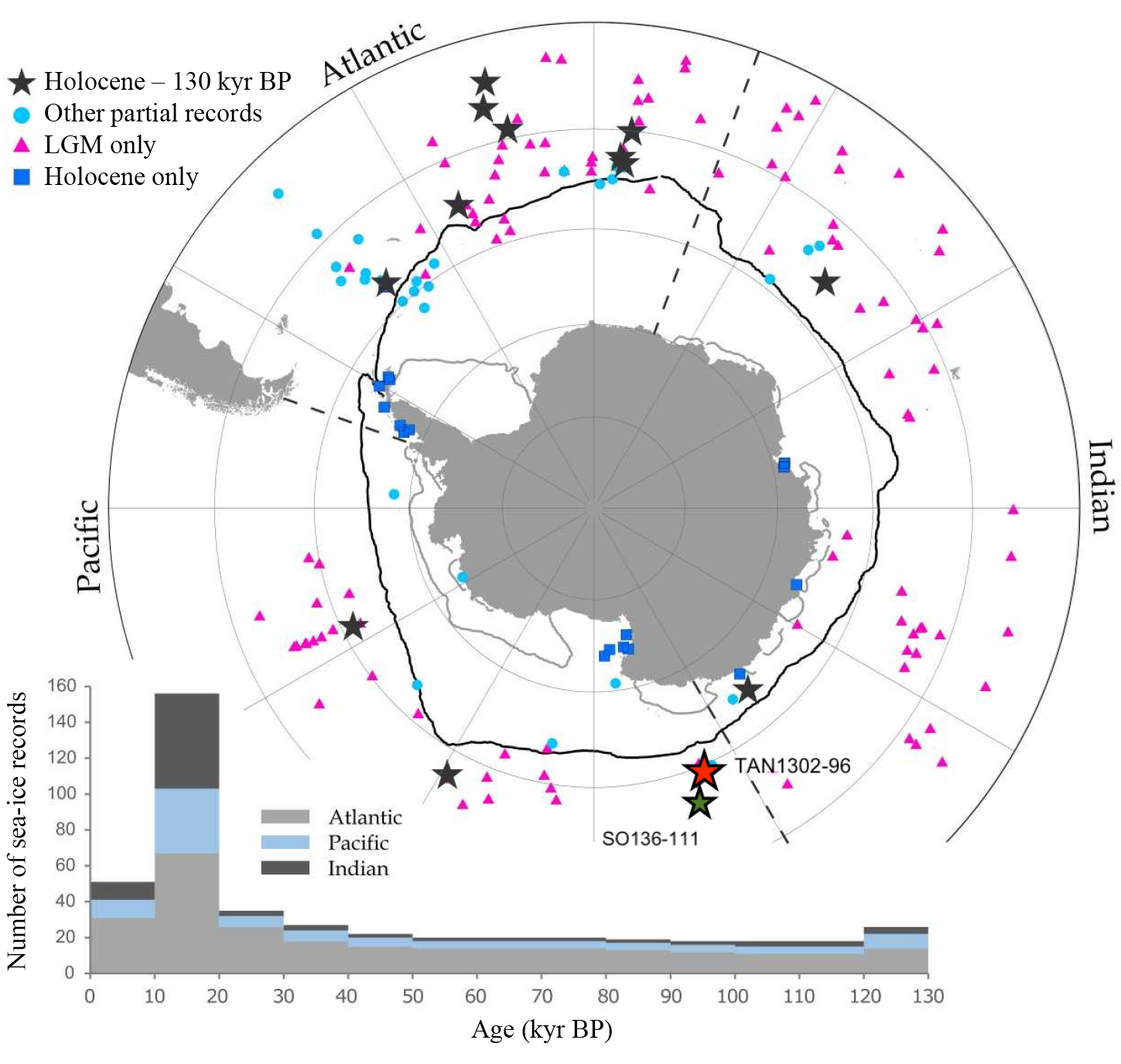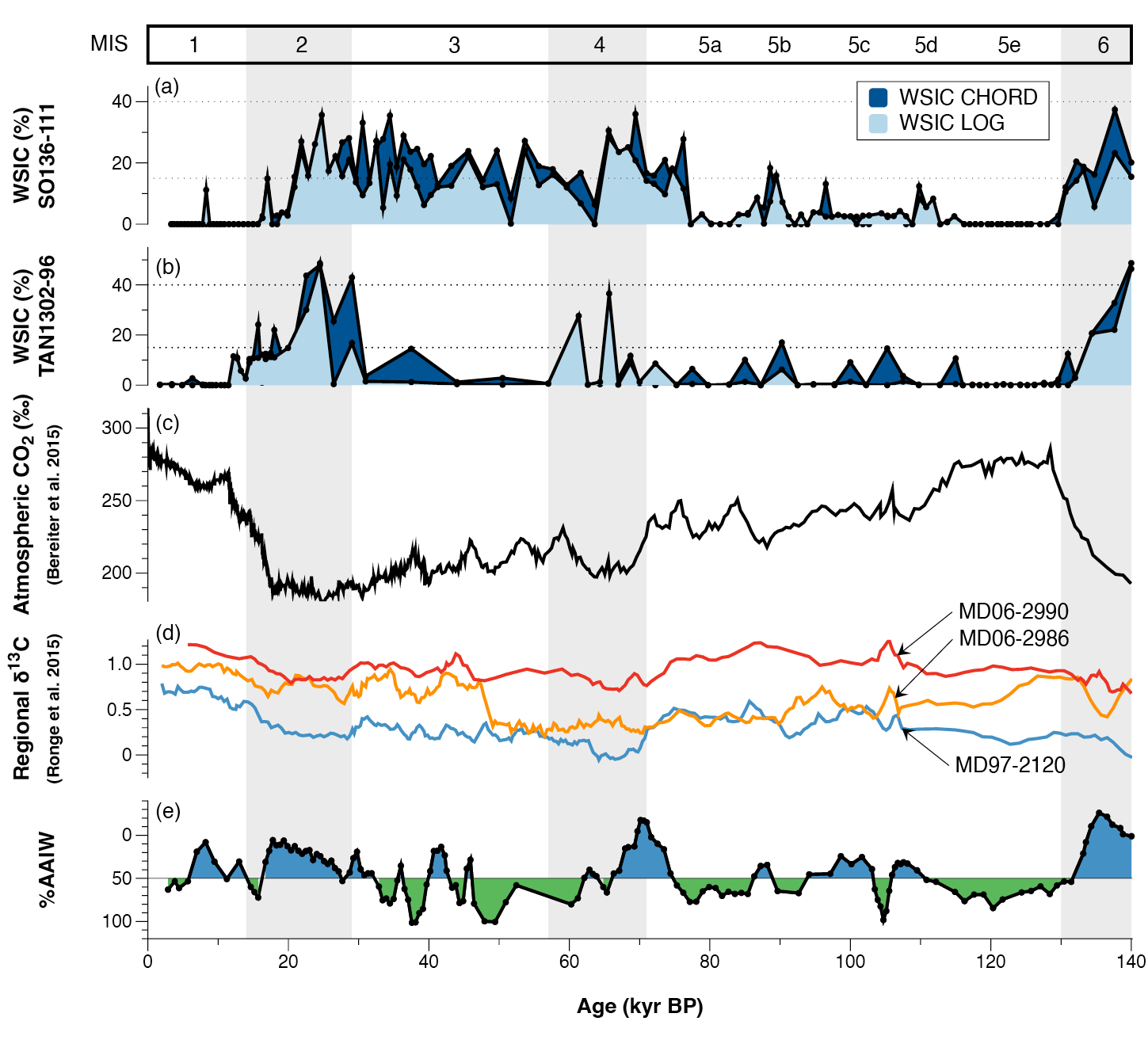- Home
- Publications
- PAGES Magazine
- The Importance of Glacial–interglacial Antarctic Sea-ice Reconstructions In Understanding Atmospheric CO2 Variability
The importance of glacial–interglacial Antarctic sea-ice reconstructions in understanding atmospheric CO2 variability
Jones J, Kohfeld KE, Bostock H & Crosta X
Past Global Changes Magazine
30(2)
88-89
2022
Jacob Jones1,2, K.E. Kohfeld1,3, H. Bostock4 and X. Crosta5
The expansion and reduction of Antarctic sea-ice coverage is hypothesized to have influenced the exchange of CO2 between the oceans and atmosphere over the last glacial–interglacial cycle (~130,000 years). However, few quantitative records currently exist. Here we highlight the importance of producing new Antarctic sea-ice reconstructions to test hypotheses relating to the role of sea ice on CO2 variability over the last glacial–interglacial cycle.
Why study Antarctic sea ice?
Ice-core records retrieved from Antarctica show glacial–interglacial variability of atmospheric carbon dioxide (CO2) concentrations of ~90 parts per million over the last few glacial cycles (Delmas et al. 1980; Neftel et al. 1982). The deep ocean has been identified as the likely location of the sequestered CO2, given the relative size of the marine carbon reservoir and the direct exchange of CO2 that occurs between the atmosphere and the surface oceans. Numerous hypotheses have been put forth to explain how the sequestration and release of carbon between these reservoirs may have occurred, including changes in biological productivity (e.g. Martin 1990), ocean reorganization (e.g. Toggweiler 1999), and changes in sea-ice coverage (e.g. Stephens and Keeling 2000), among others. However, debate continues surrounding the precise contribution of each mechanism to the total variability of CO2.
Of the hypotheses put forth, Antarctic sea-ice expansion and the related changes in ocean circulation have gained considerable attention (e.g. Kohfeld and Chase 2017). The growth and decay of sea ice influences ocean circulation, air–sea gas exchange, nutrient cycling, and marine primary production, making it a likely candidate for modulating at least some portion of the glacial–interglacial CO2 variability. The physical mechanisms associated with sea-ice growth and decay include (but are not limited to): (1) a sea-ice "capping" mechanism (e.g. Stephens and Keeling 2000) that acted to reduce air–sea gas exchange and limit the outgassing of upwelled deep waters, and (2) enhanced deep-sea stratification (e.g. Ferrari et al. 2014), which helped to stabilize the water column and reduce the upward mixing of carbon-rich waters. Fundamental to the proposed mechanisms is both a reduction in the outgassing of deep carbon-rich waters and some type of ocean reorganization, ultimately leading to enhanced carbon storage in the deep ocean.
Despite having several hypotheses linking sea-ice expansion to changes in atmospheric CO2, the current lack of quantitative reconstructions capturing a full glacial–interglacial cycle of 130,000 years (kyr) has resulted in significant uncertainty in directly attributing changes in atmospheric CO2 to changes in sea-ice extent. In order to better understand their relationship, additional glacial–interglacial reconstructions are needed to better constrain the timing and latitudinal extent of the sea-ice expansion.
What do we know about glacial–interglacial Antarctic sea-ice coverage?
Past sea-ice estimates are primarily reconstructed using diatoms, which are single-celled photosynthetic algae encapsulated in a silica frustule (shell). These algae preserve well in marine sediments for long periods of time, making them particularly useful in reconstructing past environments. The reconstruction process can either be qualitative, which uses the relative abundance of specific indicator species known to exist in narrow environmental parameters, or quantitative, which uses complex statistical methods (i.e. transfer functions) applied to the identified diatom assemblage. Most of the diatom-based sea-ice reconstructions from the Southern Ocean have focused on the Last Glacial Maximum (LGM, ~21 kyr before present (BP)), with only a handful of reconstructions extending back to the penultimate glaciation, Marine Isotope Stage 6 (MIS 6).
The current glacial–interglacial Antarctic sea-ice dataset is comprised of 14 published marine records that capture the last ~130 kyr (Fig. 1; Chadwick et al. 2022; Crosta et al. 2022). These reconstructions suggest some heterogeneity in spatial and temporal sea-ice coverage, although a general pattern exists across the Southern Ocean. Overall, the winter sea-ice edge quickly retreated during MIS 5e (~130 to 116 kyr BP), and coverage remained relatively low until the mid-glacial, where sea ice appears to have expanded during MIS 4 (beginning around ~65 kyr BP). Sea ice appears to have remained expansive and reached its maximum extent during the LGM (~21 kyr BP) before retreating and remaining relatively low throughout the Holocene.
Case study from the southwestern Pacific
Marine core TAN1302-96, retrieved from the southwestern Pacific sector of the Southern Ocean in 2013 (Fig. 1), is one of the few published marine cores that capture a full glacial–interglacial cycle (Jones et al. 2022). The age model for the core was constructed using a combination of radiocarbon dating and oxygen isotope stratigraphy, which was correlated to a global average of 57 records known as the LR04 benthic stack (Lisiecki and Raymo 2005). Using a diatom-based transfer function known as the Modern Analog Technique (Crosta et al. 1998), past summer sea-surface temperature (SSST) and winter sea-ice concentration (WSIC) were estimated back to 140 kyr BP. The TAN1302-96 reconstruction is the second glacial–interglacial record from the region, the other being SO136-111 (Crosta et al. 2004; Ferry et al. 2015), which together show a relatively coherent sea-ice history in the region over the last glacial–interglacial cycle (Fig. 2).
The timing of sea-ice expansion in the region suggests that it may not have been a key driver of early CO2 sequestration, as was hypothesized by Kohfeld and Chase (2017). However, the expansion of winter sea ice at the TAN1302-96 core site does appear to have occurred at approximately the same time as a vertical displacement of the Antarctic Intermediate Water (AAIW) and Upper Circumpolar Deepwater (UCDW) interface, as inferred from regional benthic carbon isotopes (δ13C) from nearby marine cores (Fig. 2). This δ13C record captures the isotopic composition of the waters overlying the sediments, representing periods when they were bathed primarily by UCDW (low %AAIW) or AAIW (high %AAIW). Changes in the benthic isotopic signature are therefore interpretated as changes in water-mass geometry and regional ocean circulation.
The findings from TAN1302-96 support the hypothesis put forth in Ronge et al. (2015) that the influx of low-density summer melt increased the buoyancy of the AAIW formed in the region, inhibiting its subduction and altering the volume and geometry of both AAIW and UCDW. This process, combined with a reduction in the outgassing of upwelled carbon-rich waters (i.e. the "capping" mechanism), enhanced deep-ocean stratification, and reduced upward mixing of carbon-rich waters, could have led to an increase in the glacial deep-ocean carbon pool. Taken collectively, the expansion of winter sea ice appears to have potentially influenced both the circulation of the ocean and the outgassing of CO2, which may have led to an increase in marine carbon storage.
Future work
In order to substantiate these hypotheses and better understand the role of sea ice in glacial–interglacial CO2 variability, additional records are needed from across the Southern Ocean. Specifically, transects of well-dated cores from each ocean basin would provide both: (1) critical information to constrain the timing and magnitude of sea-ice expansion, and (2) key information on underlying sea-ice and ocean dynamics. The work by the PAGES working group Cycles of Sea Ice Dynamics in the Earth System (C-SIDE; pastglobalchanges.org/c-side) has advanced our collective understanding of past sea-ice coverage by producing a number of new long-duration records and highlighting the gaps in the current knowledge.
affiliations
1School of Resource and Environmental Management, Simon Fraser University, Burnaby, BC, Canada
2Department of Geography, University of California, Los Angeles, USA
3Department of Environmental Sciences, Simon Fraser University, Burnaby, BC, Canada
4School of Earth and Environmental Sciences, University of Queensland, Brisbane, Australia
5Université de Bordeaux, CNRS, Pessac, France
contact
Jacob Jones: jbjones ucla.edu
ucla.edu
references
Bereiter B et al. (2015) Geophys Res Lett 42: 542-549
Chadwick M et al. (2022) Clim Past 18: 1815-1829
Crosta X et al. (1998) Paleoceanography 13: 284-297
Crosta X et al. (2004) Mar Micropaleontol 50: 209-223
Crosta X et al. (2022) Clim Past 18: 1729-1756
Delmas R et al. (1980) Nature 284: 155-157
Ferrari R et al. (2014) Proc Natl Acad Sci USA 111: 8753-8758
Ferry AJ et al. (2015) Paleoceanography 30: 1525-1539
Jones J et al. (2022) Clim Past 18: 465-483
Kohfeld KE, Chase Z (2017) Earth Planet Sci Lett 472: 206-215
Lisiecki LE, Raymo ME (2005) Paleoceanography 20: PA1003
Martin JH (1990) Paleoceanography 5: 1-13
Neftel A et al. (1982) Nature 295: 220-223
Ronge TA et al. (2015) Paleoceanography 30: 23-38



